Ramen Jiro: Noodles of the Gods
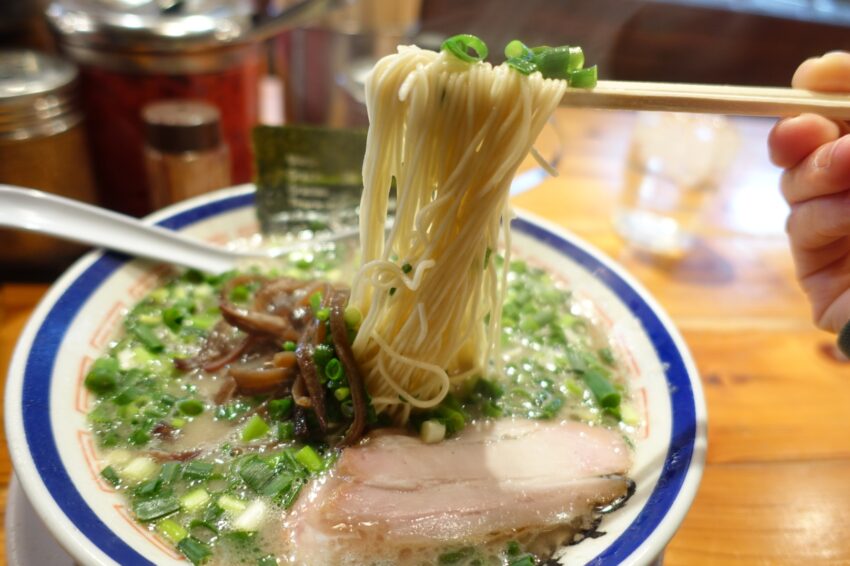
CONTENTS
Are you a fan of food? Who isn’t, right? Let me put it another way:
Do you enjoy thick, scrumptious noodles? Do you love robust, savory flavors? Does the thought of gut-busting portion sizes make your mouth water?
If you answered “yes” to any of these questions, then I’d like to welcome you to the world of Jiro-style ramen.
A Brief History of Time (and Ramen)
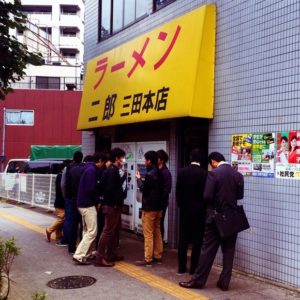
The original Ramen Jiro, a holy place for fans.
Now, most of you are probably thinking, “I know what ramen is, but what’s Jiro mean?” I’m glad you asked! Back in 1968, an entrepreneur by the name of Takumi Yamada opened a ramen shop in Meguro, Tokyo called Ramen Jiro.
Initially, the shop served a thinner, lighter style of ramen typical of your average Japanese ramen stand. However, thanks to the help of a neighboring Chinese restaurant, Yamada developed a new, distinctive taste that became known as “Jirorian style”; a fatty, salty shoyu (soy sauce) and tonkotsu (pork bone) soup base with thick, dense noodles and juicy pork chunks.
In the early 1970’s, the first Ramen Jiro moved to Mita, Tokyo. It quickly gained popularity among Keio University students due to its close proximity. In fact, when the restaurant was again forced to move in 1995, students petitioned to have it be on-campus, though it would ultimately relocate to a different part of Mita.
Now, Ramen Jiro has approximately 40 locations across Japan, over 30 of which are in the greater Tokyo area. Ramen Jiro fanatics known as “Jirorians” seek out Jiro-style ramen regularly, and often make pacts to visit all 40 Ramen Jiro locations across the country. The original Mita shop is regarded as “the sacred place” and if you’re thinking about trying Jiro-style ramen for the first time, it’s as good a place as any to visit.
The Secret’s in the Soup
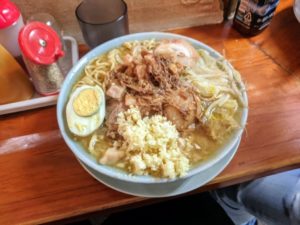
A typical bowl of Jiro-style ramen.
Now that you know the history of Jiro-style ramen and have a basic understanding of what it is, it’s time to get into details. It is my belief that for all types of ramen, the most important part of the dish is the soup. This is especially true of Jiro-style, which requires lengthy preparation. First, pork bones are boiled for hours to make the base. Ingredients such as pork fat, Japanese leeks, ginger, garlic, and cabbage are added throughout the process. Lastly, umami (‘savory taste’) seasoning is used during the plating process to complete the thick and hearty soup.
Next, let’s talk noodles. Restaurants vary in terms of whether they make their noodles in-house (the best option, in my humble opinion) or order them from an outside source, but one thing remains consistent: the thickness. Jiro-style ramen noodles are long, thick, and extremely hearty. A normal-sized portion will typically have about 200 grams of noodles in it.
Most Jiro-style places will have small, medium, and large portions, but sometimes a restaurant will have just regular or large. In such cases you can usually order a half-portion and they will give to an extra topping for free as compensation for losing the noodles at a normal-portion price.
Simply Topping!
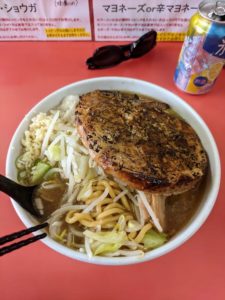
A bowl from my local Jiro-style joint, complete with “Texas Steak”.
Finally, it’s time to talk about the fixings. This is where the individual flair of a Jiro-style ramen place comes into play. The typical toppings are vegetables (typically a mix of cabbage and bean sprouts) in large quantity and one to two slices of chashu (seasoned pork belly).
Now here’s where things get interesting. One of the traits unique to Jiro-style is the ability to purchase special toppings for the dish and to tell the chef what extra free toppings you want added to the bowl during plating.
These toppings are usually listed at the restaurant and are told to the chef after prompting from them. Typical toppings include garlic, more vegetable mix, karame (a spicy sauce), or more pig fat. All toppings are available to be added in any combination and even in double amounts. There are also various other toppings available depending on the location, like boiled eggs, special dipping sauces, raw egg, and even mini season pork steaks. The result is the ability to create a customized and truly formidable dish of epic proportions.
Join the Jirorians Today!
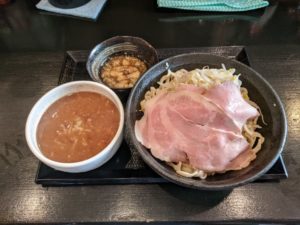
Jiro-style tsukemen.
The popularity of Jiro-style ramen has also given birth to the creation of other noodle dishes adjacent to ramen, such as Jiro-style tsukemen (cold noodles with a dipping sauce/soup) and mazesoba (a Taiwan-style dry noodle dish). Taking cues from the Jiro-style ramen, each dish follows their respective traditional fashions, but incorporates the Jiro-style portion sizes, flavors, and variety of toppings. Additionally, many ramen restaurants (with no affiliation to Ramen Jiro) have since come into existence, making their own Jiro-style ramen.
Jiro-style ramen is not for the faint of heart. Its hefty portion sizes and strong flavors can be daunting and have overwhelmed many a customer. A small-sized bowl of it has around 1600 kcal, whereas the average small-sized bowl at a typical Japanese ramen shop contains about 600 kcal. Due to this style of ramen being high in carbohydrates and fats with little nutritional value, it is often described as a ‘junk food’ by critics.
However, it is a truly unique dish that should be tried at least once in a lifetime if you are given the chance to do so. And who knows? You too could become a Jirorian of the Church of Ramen Jiro like I have.
Photo Credits:
Additional photos provided by Connor Steck
All other content (text) created by the original author and © 2020 MUSUBI by Borderlink
RELATED
-

Good Eats: The Onion Burgers of Awaji
Top Image: yhp511 on Pixabay Works of antiquity such as the Kojiki and Nihonshoki describe Awaji Island as the… -
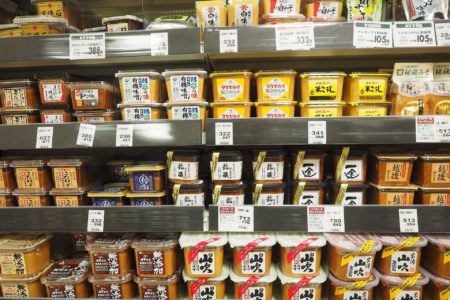
My Mighty Miso Adventure
Top Image: othree via Wikipedia, licensed under CC By 2.0 Miso (味噌) is fermented soybean paste that at first g… -

Must-Haves: Medicines at the Drugstore
Top Image Courtesy of Kristine Mayor When it comes to first aid in the home, it’s always best to be prepared w…
PEOPLE

Connor Steck
From the US
Started his new life in Japan with a year in Hokkaido!



